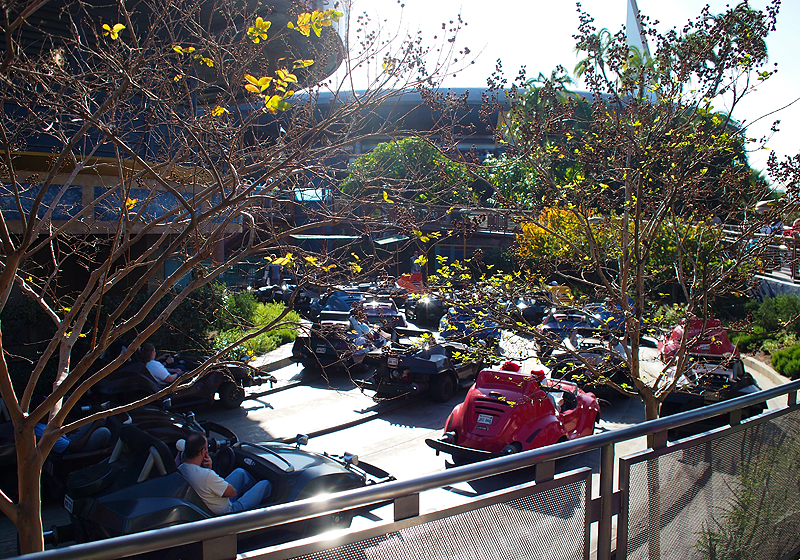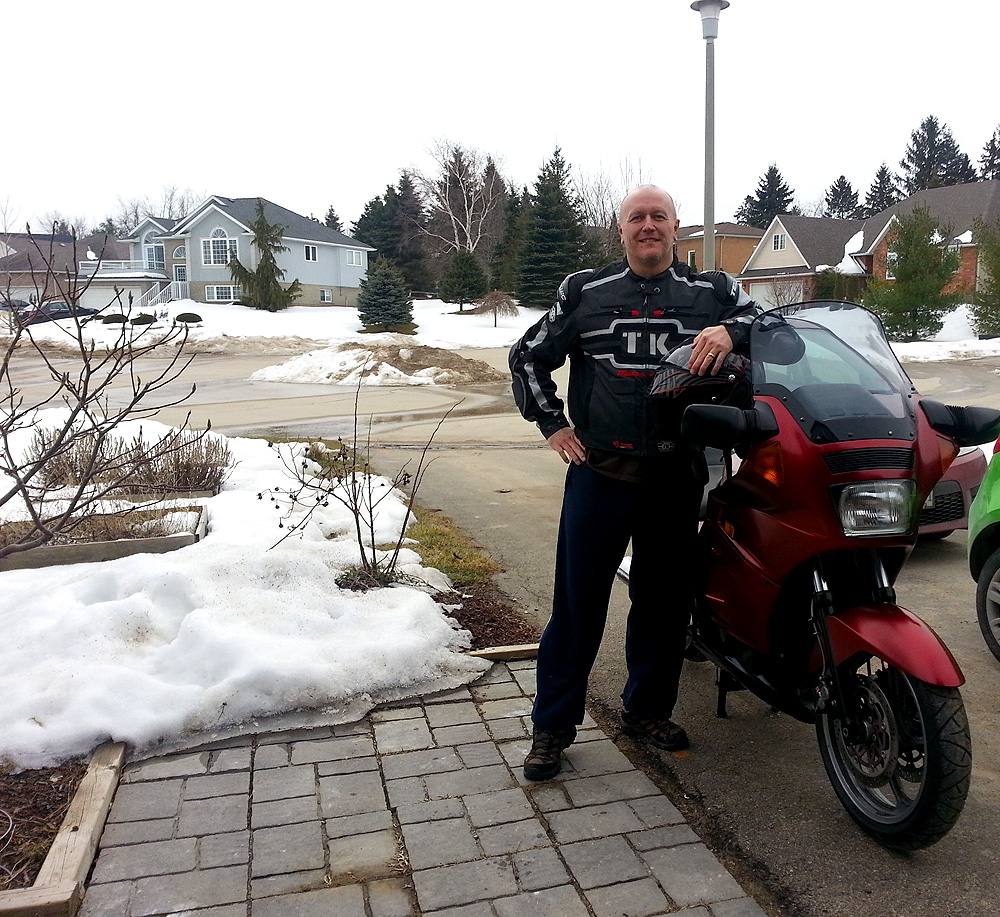I went to California for the first time over the mid-winter break. I was out there on a family trip so I didn’t have many opportunities to ride, but while there I made a point of trying to understand California biking culture. When you can ride year round biking becomes much less of a niche means of transport.
Here are some snap shots and thoughts from the trip:
LANE SPLITTING or FILTERING
This is something that is a real no-no up here in the safety North. Talking to a cabbie about it, he said you need to be really careful about changing lanes. If you hit a filtering biker while changing lanes in a cage you’re likely to take the blame.
 Riders in California expect cars to not crowd the gaps between lanes and will make them aware of it if they do. I saw a guy on a sports bike revving the snot out of it to move an SUV out of his way while he was filtering.
Riders in California expect cars to not crowd the gaps between lanes and will make them aware of it if they do. I saw a guy on a sports bike revving the snot out of it to move an SUV out of his way while he was filtering.
At first lane splitting looked like a dangerous thing to do, but if it makes cage drivers more aware of bikers and offers a real advantage to getting through the attrocious L.A. traffic for riders, then I’m coming around.
LOS ANGELES IS BROKEN
From the moment we landed at the most disorganized airport I’ve ever been to (LAX) and the subsequent traffic chaos all around L.A., I’ve come to the conclusion that the place is broken.
 |
Rides at Disney world appear to mimic the hell that is driving
in LA with remarkable accuracy – do people do this for fun? |
The roads in the rest of California were lovely, but around L.A. they make Ontario’s frost heaved slabs look smooth. With virtually no public transit infrastructure and a fanatical car culture, L.A. is the kind of place you can expect to spend half of your life sitting in traffic.
On a coach trip out to Universal Studios I was able to look down into the cars sitting in traffic. At any one time more than 90% of the drivers had a smartphone out on their laps. We saw many accidents in the L.A. area – every single one was an unexplained rear-end collision. I can explain those ‘accidents’.
L.A.’s car culture has become L.A.’s distracted driving culture. I’d rather drive in Tokyo or London than L.A. any day of the week. They say Toronto’s commute is now worse than L.A.’s, but Toronto (GTA ~6 million) is a tiny burg compared to Los Angeles (>18 million). The dozens of highways that bisect L.A. aren’t up to handling the full on assault of those millions of thumb texters behind the wheel.
 L.A. STUNTING
L.A. STUNTING
While sitting in traffic (behind another unexplained rear end collision) we had a group of sports bike riders doing their thing on the access road next to the highway. The group must have been almost one hundred big and were all revving, wheelying and otherwise stunting themselves silly on a sunny new year’s day.

It was fun to watch them while we crawled along interminably in the never ending freeway traffic. The bikes were all very customized with both paint and go-faster bits, and their riders looked like they were having a riot.


You might frown at their antics, but when you consider the alternative is to sit in the cavalcade of metal boxes on the freeway, texting before you run into someone, I’m not sure if they don’t have the right idea.
I thought they were more entertaining than any of the very serious pirates we saw filtering by on their Harleys on the highway.
 MULHOLLAND DRIVE
MULHOLLAND DRIVE
Is one of those icons of Southern California, so I made a point of making the drive down it. It’s a very long stretch of road that eventually turns into the Mulholland highway and goes all the way to the ocean.
We started at the beginning right out of Studio City in Burbank and the road was terrible! I guess rich people don’t live on this bit. You’d need an ADV bike to make any time on tarmac this bad. For a place that doesn’t get much frost, I’m not sure how their roads can be this rough.
 Fortunately, once you get past the first bit the pavement improves dramatically (rich people live here). The ride is fantastic and the road (named after the engineer who built it) is a testament to imaginative road design over challenging terrain. We turned off on the 405 and headed to the airport to fly home to freezing Ontario, but Mulholland deserves a look if you’re in Southern California, just grit your teeth on the opening stretch.
Fortunately, once you get past the first bit the pavement improves dramatically (rich people live here). The ride is fantastic and the road (named after the engineer who built it) is a testament to imaginative road design over challenging terrain. We turned off on the 405 and headed to the airport to fly home to freezing Ontario, but Mulholland deserves a look if you’re in Southern California, just grit your teeth on the opening stretch.

PALOMAR MOUNTAIN
I’ve had a poster of the Hale telescope on Mount Palomar on my wall since I was a kid. The chance to see it in the flesh was one of the highlights of this trip for me. The trip up the mountain, from sea level to five and half thousand feet, looked pretty epic too.
 I, unfortunately, had to do the road in a rented RAV4, which felt like a double decker bus loaded with lead. The happier people at the top had a variety of two wheel conveyances to get them there, with sports bikes being the clear favourite – not a cruiser in sight.
I, unfortunately, had to do the road in a rented RAV4, which felt like a double decker bus loaded with lead. The happier people at the top had a variety of two wheel conveyances to get them there, with sports bikes being the clear favourite – not a cruiser in sight.
The guys hanging out at Mother’s Kitchen (great veggie food!) were an all ages sports bike party, with Keith Code look-a-likes and younger riders all chatting amiably about their machines and the road.
Bikes ranged from super sports and even sport tourers like the Interceptor to light-weight nakeds.
 It was a cool day in late December when we went up the mountain. The temperature dropped from high teens to about twelve degrees at the summit – all sunny though. The riders didn’t seem cold. Riding up that insanely wiggly 20+ miles of mountain road would be an aerobic workout of the first order.
It was a cool day in late December when we went up the mountain. The temperature dropped from high teens to about twelve degrees at the summit – all sunny though. The riders didn’t seem cold. Riding up that insanely wiggly 20+ miles of mountain road would be an aerobic workout of the first order.
 The observatory itself is completely free to the public, offers parking and a museum with crazy-cheap merchandise (if astronomy hoodies are your thing). You could spend a perfect day riding up and around Palomar mountain before going for a walk around one of the biggest mirrors in the world.
The observatory itself is completely free to the public, offers parking and a museum with crazy-cheap merchandise (if astronomy hoodies are your thing). You could spend a perfect day riding up and around Palomar mountain before going for a walk around one of the biggest mirrors in the world.
With a variety of roads, a state park, the observatory and that lovely little restaurant, Palomar mountain just outside of San Diego is a great destination for any biker, and a must see for those bikers with the astronomy bug.
A few days after our trip up there it snowed, but for most years this is the exception rather than the rule.
PRICES IN A YEAR ROUND BIKING CULTURE
While in La Jolla (just north of San Diego), I checked out some of the local bike shops. The prices are heart stoppingly low if you’re used to Canadian numbers. You might find a one piece leather suit up here for $600 on the bottom end, but down there the same level of kit is half the price. Out of curiosity, I wondered what it would cost to outfit myself to ride with all new kit down here. At Cycle Gear in San Diego it ended up being a shade over $300 for a new helmet, gloves, boots, riding pants and jacket… unreal!
SUMMARY
If you like to ride, California offers some fantastic roads (not in the L.A. area) that beg to be explored. We also hit Joshua Tree National Park on our travels and it is other wordly! There are few straight lines, even riding the hilly highways around San Diego would feel special to someone from table-flat Ontario. There is a vibrant, large biking culture that shows through in the shear variation you see. I can’t wait to go back and experience the place as it was meant to be experienced, on two wheels.




































